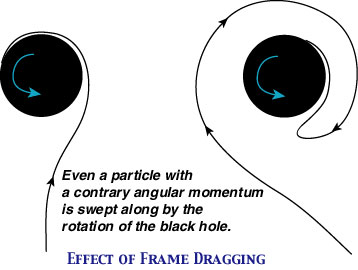

The Spinning Black Hole
The Spinning Black Hole
Kip Thorne tells us an interesting story about Roy Kerr (Thorne 1994, 341-2), when he presented his solution for the spinnng black hole (which was made clear some ten years later) at the conference held in Dallas in 1963 (Thorne himself saw the scene). Most of the audience did not notice the importance of Kerr's work, and ignored his presentation.
Now, Taylor and Wheeler touches on the spinning black hole in Project F (Taylor & Wheeler 2000, F-1-33), so that you can have a glimpse of it. They present the Kerr metric in the equatorial plane, assuming that the spinning black hole has an extreme angular momentum. As was the case with the Schwarzschild geometry, Kerr solution is for an isolated star, but with spin, i.e. with angular momentum. The angular momentum per unit mass is written J/M, and it is often abbreviated as a. ("Extreme" means that we put a = M in the following equation of the Kerr metric.)
Usually, a spinning black hole is not literally isolated, since it is surrounded by matter or gas attracted by the black hole. Thus it has the accretion disk around it, and two jets along the axis of rotation, as the following figure shows. But in the following we will ignore this.
The Kerr metric is complicated, and looks like this:
For the analytic treatment, see Taylor & Wheeler; here, you do not have to worry about details, except for some qualitative features. The major differences of Kerr metric from Schwarzschild metric are nicely summarized by Taylor and Wheeler as follows:
(1) According the the Kerr metric, the r-coordinate of the horizon is different, depending on a; and this metric is expressed, not in Schwarzschild coordinates but in Boyer-Lindquist coordinates.
(2) In the Kerr metric, a new, cross product factor dtdƒÓ appears. This means that time and angular velocity is closely related, and the upshot is the frame dragging, which may be roughly expressed by saying that the spacetime around the black hole is dragged by the rotation. The figure (which is a view of the far-away book-keeper, similar to the Schwarzschild book-keeper) is adapted from Thorne 1994, 7.8, 292.

(3) The third difference is the separation of the horizon and the static limit which is closely related to the value 2M; see the figure, which is adapted from Taylor & Wheeler's Figure 1 (F-8) of Project F. Within the ergosphere in between the horizon and the static limit, everything is swept along by the rotation.
(4) Finally, the spinning black hole can supply energy because of its rotation; and it is called live black hole in contrast to the static, dead black hole of Schwarzschild geometry. Thus, Kip Thorne describes a project for extracting energy from the spin of a black hole (Thorne 1994, 53-4; see figure P. 6).
Reference
Taylor, Edwin F. and Wheeler, J. A., Exploring Black Holes, Addison Wesley Longman, 2000.
Thorne, Kip (1994) Black Holes and Time Warps, Papermac, 1994.
Last modified March 31, 2003. (c) Soshichi Uchii